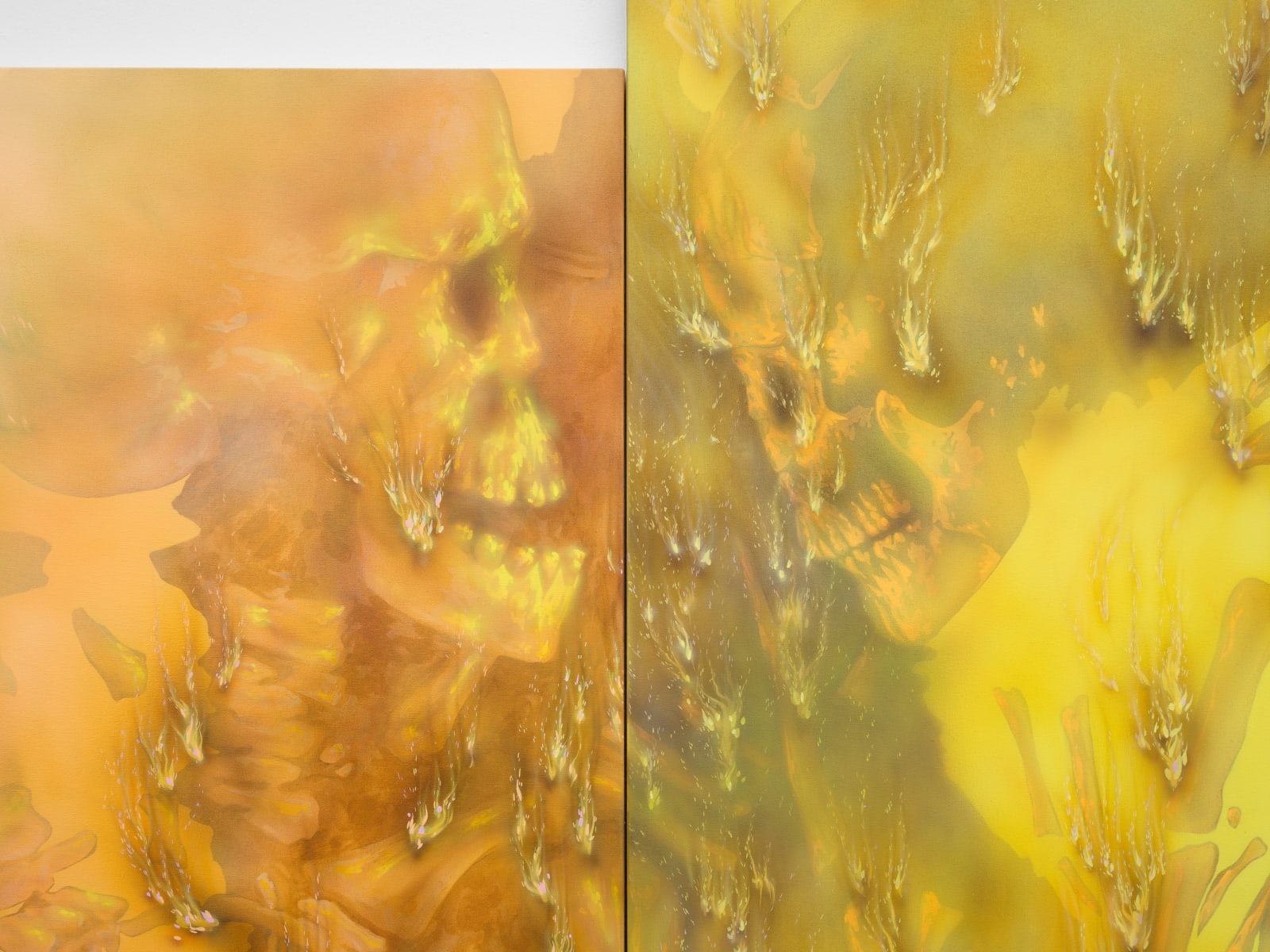Natacha Donzé
Death needs no proof, it consumes it all, 2025
Acrylic on canvas
2 panels:
180 x 80 cm
70 7/8 x 31 1/2 inches
210 x 100 cm
70 7/8 x 31 1/2 inches
180 x 80 cm
70 7/8 x 31 1/2 inches
210 x 100 cm
70 7/8 x 31 1/2 inches
Copyright The Artist
Photo: Marjorie Brunet Plaza
Weitere Abbildungen
In “Death needs no proof, it consumes it all” (2025) stehen sich zwei Skelette in strahlenden Gelb- und Orangetönen gegenüber. Ihre Oberflächen scheinen wir digitale Häute, die Spuren chemischer Verbrennungen...
In “Death needs no proof, it consumes it all” (2025) stehen sich zwei Skelette in strahlenden Gelb- und Orangetönen gegenüber. Ihre Oberflächen scheinen wir digitale Häute, die Spuren chemischer Verbrennungen tragen, schwebend zwischen künstlichem Leuchten und körperlicher Präsenz. Sie bewegen sich zwischen technologischer Aura und ursprünglichen Emotion und deuten darauf hin, dass Glaube, Liebe und Verlust sich behaupten, indem sie alles in ihren Kreislauf aufnehmen. Wie „Not built, but born“ (2025) verweist das Werk auf etwas, das nicht konstruiert, sondern nur hervortreten kann: eine Form, die zugleich lebendig, ein Portal und doch ungreifbar ist. Der Titel wirkt dabei ebenso wie eine Aussage wie eine Beschreibung und hält das stille Spannungsfeld zwischen Beweis und Verschwinden zusammen. Natacha Donzé greift dabei auf historische Referenzen und Abbildungen von Skeletten zurück, in denen sich Paare in enger Umarmung begegnen. In diesen Bildern scheinen Intimität und Tod untrennbar verbunden und stellen zugleich die Frage nach dem, was überdauert.
In “Death needs no proof, it consumes it all” (2025), two skeletons face each other in stillness. Their surfaces carry traces of chemical burns and digital membranes, hovering between artificial glow and bodily presence. The work is situated between technological aura and primal emotion, suggesting that faith, love, and loss assert themselves by absorbing everything into its cycle. Like “Not built, but born” (2025), it points to something that cannot be constructed but only emerges: a form that is at once living, a portal, and intangible. The title becomes a statement as much as a description, holding together the work’s quiet tension between proof and disappearance. Natacha Donzé draws on historical references and illustrations of skeletons in which couples embrace each other closely. In these images, intimacy and death seem inextricably linked, while at the same time raising the question of what endures.
In “Death needs no proof, it consumes it all” (2025), two skeletons face each other in stillness. Their surfaces carry traces of chemical burns and digital membranes, hovering between artificial glow and bodily presence. The work is situated between technological aura and primal emotion, suggesting that faith, love, and loss assert themselves by absorbing everything into its cycle. Like “Not built, but born” (2025), it points to something that cannot be constructed but only emerges: a form that is at once living, a portal, and intangible. The title becomes a statement as much as a description, holding together the work’s quiet tension between proof and disappearance. Natacha Donzé draws on historical references and illustrations of skeletons in which couples embrace each other closely. In these images, intimacy and death seem inextricably linked, while at the same time raising the question of what endures.









